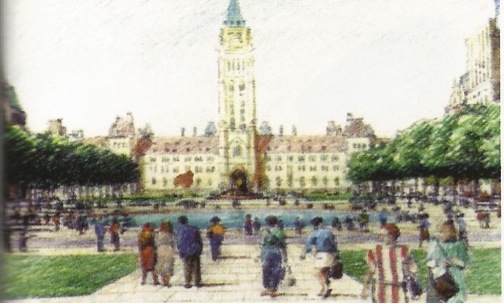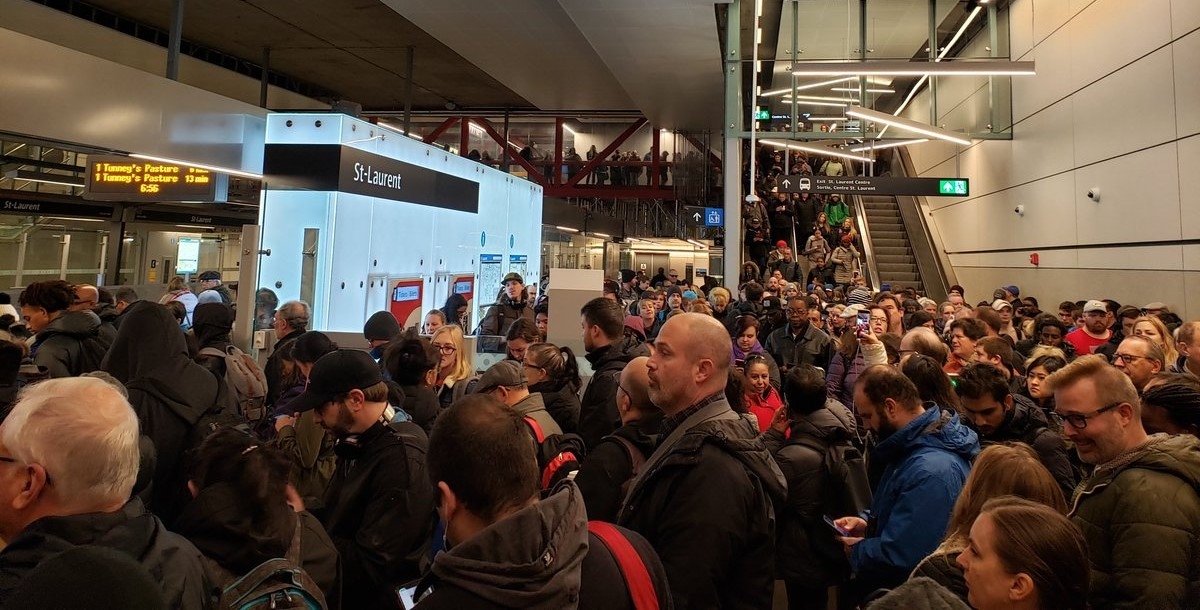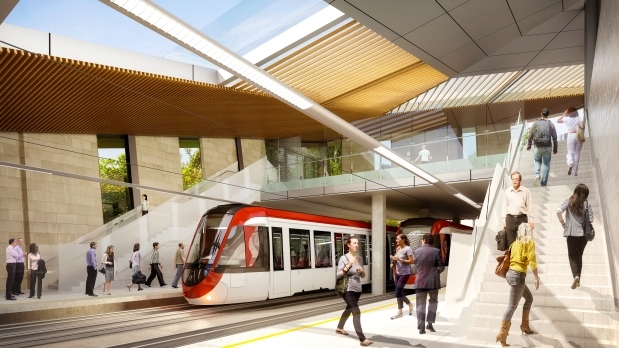
Ottawa’s grand boulevard: Vision or nightmare
By Jeannie Dempster
In the mid-1800s, Parisian architects redesigned the entire city, replacing the twisty medieval streets with long, wide boulevards. Given the many violent uprisings of that era, the military favored the new roads, for they provided a much better view down the gun barrel at the angry mobs storming towards them.
Fast-forward to 1999, to 'caring and compassionate' Ottawa. The National Capital Commission (NCC) has brought forward a controversial plan to expand Metcalfe Street into a Parisian-style 'grand boulevard, opening it up and destroying the west side of Metcalfe Street as far south as the old Museum of Nature on McLeod Street. The idea is to create 'a unique public space and vista, focused on the Peace Tower, to connect Parliament Hill to the City at the heart of the Capital' and to 'improve the visibility of Parliament Hill and the attractiveness of downtown, for visitors and residents alike: Rest assured, of course, that the only firing of weapons would be ceremonial.
Although this is still only an 'idea' and not a formal plan, the NCC has put this proposal in writing, within the context of a larger plan entitled A Capital For Future Generations —Vision for The Core Area of Canada's Capital Region. The NCC presented this idea to the City of Ottawa and to Regional Council in June.
Reactions were swift and, for the most part, extremely negative. What at first glance sounds and looks like a wonderful, imaginative plan to further beautify Ottawa, said city council, is in reality a ridiculous and frivolous idea. "It's surprising that this initiative got off the drawing board," Ottawa Mayor Jim Watson says.
You don't have to dig very deeply to find out why city council and many others are so vehemently opposed to this particular aspect of the NCC plan for the future of Ottawa. Just sit down for a chat with Stanley Lithwick, owner of the Plaza Café on Sparks Street. His restaurant is housed in the former Birks Building, and is now owned by the federal government.
Lithwick opened his restaurant in 1991, after a lengthy battle. Naysayers at the time felt that having a restaurant so close to the 'Parliamentary Precinct' would detract from the area — that the 'Town' was encroaching on 'Crown' space. Yet Lithwick convinced Public Works Canada to lease him the space, and his business has been booming ever since. By day, the restaurant is filled with parliamentary types and tourists. Since 1996, the same space has doubled as a swinging night-club — The After Eight Jazz Club.
Yet when Lithwick recently approached Public Works and Government Services Canada for a 10-year extension on his lease in addition to the five remaining, he was shocked by the response. Public Works spokeswoman Louise Proulx told The Ottawa Citizen in September that "we will not negotiate longer-term leases until decisions have been made regarding the future use of the building!"
The problem for Lithwick is that the NCC has the overriding power to expropriate any land it deems necessary to fulfill an architectural vision. The fact that the federal government already owns the building housing the Plaza Café is a further blow for Lithwick. This hurts his business now, for it is next to impossible to run a successful business when in five years' time — when his current lease is up — or less, that same business may no longer exist.
In fact, given the number of businesses potentially affected by the widening of Metcalfe, it is surprising that so few business people besides Lithwick have spoken out on this issue. The Sparks Street Improvement Area, an organization whose purpose is to keep the best interests of its tenants in mind, has been strangely silent on this matter. Peter Harris, the new executive director of the Improvement Area, told me that his position is that of manager, and as such, it is not his role to comment on the possible implications of this proposal. Harris suggested I speak to Improvement Area chairman Stanley Ages, owner of Yesterday's Restaurant & Parlour (at Sparks and O'Connor). At press time, Ages had not responded to a request for an interview.
However, Lithwick has other allies in this fight. Local architect and businessman Barry Padolsky of Barry Padolsky Architect Ltd., is a respected authority on heritage buildings. In 1993, Padolsky was hired by Public Works Canada to do an architectural study of five buildings spanning Wellington and Sparks streets.After examining the former Birks Building, the Four Corners Building, the Marshall Building (which houses the newly renovated Capital Infocentre), the Bate Building —just west of the Plaza Café — the Bank of Commerce Building, and the U.S. Embassy Building, Padolsky concluded that they were all of significant heritage value.
Public Works agreed, and the five buildings received heritage protection from the Federal Heritage Building Review Office. They were given 'recognized' status, the second highest rating for a heritage building. The highest rating is classified, and applies only to the Parliament Buildings.
Any version of the Metcalfe Street plan would involve the destruction of these 'recognized' buildings. This fact has led to the informal suggestion by the NCC that some or all of these buildings could be moved to other locations.
Padolsky noted in response to this suggestion that a heritage building is "not a moveable piece of furniture. A significant part of its value is its location:" In this case, the `south wall' of Wellington Street is seen to be an integral part of the Parliamentary Precinct. Indeed, the 'south wall' concept dates back to the 1950s, and well-respected NCC architect Jacques Greber's visionary plan for the national capital.
It is interesting that, almost 50 years later, Greber's plan is being used by both sides of this debate as justification for or against the proposal. Padolsky, as part of his submission to the NCC against the Metcalfe proposal, included excerpts from Greber's Plan for the National Capital, 1950. At that time, Greber studied the idea of having Metcalfe Street serve as the primary route to the Parliament Buildings. After examining this possibility, he ruled it out for several reasons, the main one being that it would actually diminish the view of the Parliament Buildings.
"But the principle reason for its rejection was on the grounds of aesthetics. The architectural characteristics of the Parliament Buildings are basically Gothic, adapted to the Victorian mode. Even if the East and West blocks were subjected to architectural modifications in the future, the whole would retain its picturesque character and any develop-ment of its silhouette would gain by not being observed symmetrically but angle-wise, which would ameliorate the volume of the Peace Tower, the elongation of which, when seen from the front, is emphasized. For this reason, in addition to those already outlined, we abandoned the projected widening of Metcalfe Street, in favor of the oblique perspective of the Parliament Buildings from the future main entrance to the City, paralleling the east side of the Rideau Canal. From this area, . . . the view of the Parliament Buildings is already very imposing." (Excerpt, pages 179-180)
The other main entrance alluded to is Elgin Street, which is already widened, and which is now considered part of the Parliamentary Circle, with the War Memorial at its apex. Indeed, current construction at Wellington and Elgin is underway to expand this area for motorists and pedestrians alike.
Yet, regional government chairman Bob Chiarelli claims that the "instant negativity" to the Metcalfe proposal is a "knee-jerk reaction." According to Chiarelli, there is more merit in taking a "wait and see" approach. Instead of voting immediately against the proposal, as city council did, regional council decided to withhold further comments until the NCC releases its Public Consultation Report in the New Year.
In his reasoning, Chiarelli also refers to the works of Jacques Greber. He notes that another major project of Greber's was the Green Belt. Now considered sacred, Chiarelli recalls that at the time, the Green Belt plan required the expropriation of dozens of family farms, and the closing of streets and family businesses, creating a huge public outcry. Today, citizens groups protect this same area, and Greber is considered a genius, Chiarelli says.
The regional chairman cited the Western Parkway as another example of NCC land expropriation that was extremely good for the City of Ottawa. One has to think of Metcalfe Street 20 to 30 years from now for a true "test of the NCC's vision," says Chiarelli.
However, others note that this is about the worst time to entertain a proposal of this magnitude. Walter Robinson, federal director of the Canadian Taxpayers Federation, says that he too is against the Metcalfe Street expansion. His first consideration is what this will mean for all Canadian tax-payers. In an era of tough choices and declining budget resources, Canadians should be made aware of the costs of such a project, he notes. While no figures are available, demolishing and moving buildings, buy-outs and construction would cost hundreds of millions of dollars. Robinson notes that Ottawa taxpayers would face a "double whammy," as their taxes would not only pay for the project, but their property taxes would be greatly affected (upwards, more than likely).
Robinson notes that, in recent years, the NCC has actually been a model of innovative and forward thinking, and the Crown agency's internal restructuring has resulted in saving tax-payers money. It is unfortunate, Robinson says, that the NCC's current plan, otherwise filled with good ideas, contains this singular proposal, which serves to "diminish the institutional credibility" of the federal agency.
One particularly expensive aspect of the plan will be the necessity of tearing down the 16-storey second tower at the World Exchange Plaza, which lies in the path of the proposed Grand Boulevard. The tower hasn't even been built yet, but the City of Ottawa and the NCC have given their approval for the project! Robinson is also concerned with the lack of commentary emanating from local Members of Parliament. He believes that Mac Harb, Liberal MP for Ottawa Centre, has been "conspicuously silent" on this issue. In fact, Harb did hold a public meeting last summer to debate the proposal. He also polled his riding on the issue in a recent Householder, asking constituents to send him their responses. At this time, though, Harb's office is not releasing the results of that poll.
David Gladstone, chairman of the Centretown Citizens Community Association, attended last summer's meeting, as did representatives of the NCC. Gladstone says the NCC representatives told people that, while there would be some sacrifice, it would be worth it. When Gladstone asked the NCC to list the specific benefits of the Metcalfe Street proposal, the only response was that there would be "more room for crowds on Canada Day"
His group is particularly concerned with the potential displacement of at least 1,000 residents within the Centretown area, should the plan move ahead. Gladstone believes an effective cost-benefit analysis of the street widening should be carried out.
In his response to the NCC, Chiarelli said he was concerned for the well-being of downtown residents. His criteria for the Metcalfe plan includes initiatives for getting people to live downtown again, after the dust has settled. In fact, the NCC has promised that, regardless of whether it receives regional government support or not, it is committed to developing LeBreton Flats, an area now owned largely by the NCC, and which has remained vacant for 35 years.
Regional council is very interested in seeing the LeBreton development proceed, and would like to further examine its residential potential as part of the NCC's overall 'Vision'.
When regional council deliberated over the proposal last summer, NCC chairman Marcel Beaudry contacted Chiarelli, along with individual members of council, and asked them to hold off on any decision. Beaudry said the NCC was completely re-evaluating the concept, and would have a new proposal ready for early 1999.
While regional council agreed to wait, one regional councillor saw a red flag in this NCC manoeuvre. Councillor Diane Holmes started out supporting the NCC proposal. Then she started talking to people. When she heard about the potential demolition of heritage buildings, and what it would do to people and businesses in the area, she changed her mind. She is now convinced that the widening of Metcalfe Street would "sap vitality from downtown?' What concerned her even more, though, was the fact that Beaudry, in contacting the councillors, was interfering in the democratic process. Voting on such an important matter to her constituents is an integral part of the public process, Holmes said. It was extremely "inappropriate" for Beaudry to ask her and other councillors, including the regional government chairman, to forego the democratic process.
City councillor Elisabeth Arnold agrees. Representing Somerset Ward, Arnold is also a member of the City's Planning and Economic Development Committee. The committee staff carefully reviewed the NCC's report, giving it a "vigorous technical analysis," Arnold said. Although there were many positive aspects to the "Vision" proposal, such as the extension of Bank Street to the Ottawa River, development of the Daly site and (finally!) reconstruction of the LeBreton Flats wasteland, the councillors were firmly opposed to Metcalfe Street's widening. While Arnold is will-ing to listen to the NCC's response in the New Year, she, like Holmes, is concerned over Beaudry's actions in contacting her and other councillors. Arnold became "really alarmed that the NCC was not open to our objections?' Now that these objections are in the public record, Arnold hopes the NCC will give them careful consideration.NCC spokesman Luc Begin emphasizes that the proposal put forward to both councils was an "idea" only, and that this "was made clear from the start?' He said the public is wel-come to respond to the idea through comment sheets, letters and calls, and acknowledges the public's concerns over loss of heritage buildings and economic viability. "All comments will be taken into consideration" as the public report is being prepared. Begin also notes that, even after the report is issued in the New Year, the NCC will continue to refine its options, based on the public's views.
However, there is a feeling among the public that the NCC will not let this proposal die so easily, because pressure is being brought to bear on the agency from the Prime Minister's Office. It is a well-known rumor that the widening of Metcalfe Street is a pet project of Prime Minister Jean Chretien, who would like to see the new square created as a legacy to his term in office. The concern is that Beaudry is being particularly heavy-handed with this matter at the behest of the Prime Minister himself.
Jennifer Lang, spokeswoman for the Prime Minister, stated that Chretien "has been kept aware of the new plan for Ottawa" and that he is "anxious to see the public's reaction during the consultation process. He's very supportive of that process."
Meanwhile, Stanley Lithwick and other business owners along Metcalfe Street must wait, their lives on hold for what now exists only as "a concept." A third-generation Ottawa native, Lithwick is so upset that, should this plan go through, he may leave Ottawa — or even Canada — altogether, his pride in Canada shaken to the core.








